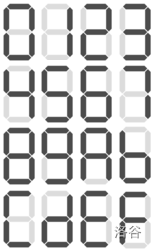#P14104. [ZJCPC 2017] Seven Segment Display
[ZJCPC 2017] Seven Segment Display
题目描述
A seven segment display, or seven segment indicator, is a form of electronic display device for displaying decimal numerals that is an alternative to the more complex dot matrix displays. Seven segment displays are widely used in digital clocks, electronic meters, basic calculators, and other electronic devices that display numerical information.
Edward, a student in Marjar University, is studying the course "Logic and Computer Design Fundamentals" this semester. He bought an eight-digit seven segment display component to make a hexadecimal counter for his course project.
In order to display a hexadecimal number, the seven segment display component needs to consume some electrical energy. The total energy cost for display a hexadecimal number on the component is the sum of the energy cost for displaying each digit of the number. Edward found the following table on the Internet, which describes the energy cost for display each kind of digit.
$$\begin{array}{|c|c|c|c|} \hline \text{Digit} & \text{Energy Cost} & \text{Digit} & \text{Energy Cost} \\ & \text{(units/s)} & & \text{(units/s)} \\ \hline 0 & 6 & 8 & 7 \\ \hline 1 & 2 & 9 & 6 \\ \hline 2 & 5 & A & 6 \\ \hline 3 & 5 & B & 5 \\ \hline 4 & 4 & C & 4 \\ \hline 5 & 5 & D & 5 \\ \hline 6 & 6 & E & 5 \\ \hline 7 & 3 & F & 4 \\ \hline \end{array} $$:::align{center}
 :::
:::
For example, in order to display the hexadecimal number 5A8BEF67 on the component for one second, units of energy will be consumed.
Edward's hexadecimal counter works as follows:
- The counter will only work for seconds. After seconds the counter will stop displaying.
- At the beginning of the -st second, the counter will begin to display a previously configured eight-digit hexadecimal number .
- At the end of the -th second (), the number displayed will be increased by . If the number displayed will be larger than the hexadecimal number
FFFFFFFFafter increasing, the counter will set the number to and continue displaying.
Given and , Edward is interested in the total units of energy consumed by the seven segment display component. Can you help him by working out this problem?
输入格式
There are multiple test cases. The first line of input contains an integer (), indicating the number of test cases. For each test case:
The first and only line contains an integer () and a capitalized eight-digit hexadecimal number (), their meanings are described above.
We kindly remind you that this problem contains large I/O file, so it's recommended to use a faster I/O method. For example, you can use scanf/printf instead of cin/cout in C++.
输出格式
For each test case output one line, indicating the total units of energy consumed by the eight-digit seven segment display component.
3
5 89ABCDEF
3 FFFFFFFF
7 00000000
208
124
327
提示
For the first test case, the counter will display hexadecimal numbers (89ABCDEF, 89ABCDF0, 89ABCDF1, 89ABCDF2, 89ABCDF3) in seconds. The total units of energy cost is
$$\begin{matrix} (7 + 6 + 6 + 5 + 4 + 5 + 4 + 6) & + & \\ (7 + 6 + 6 + 5 + 4 + 5 + 4 + 2) & + & \\ (7 + 6 + 6 + 5 + 4 + 5 + 4 + 5) & + & \\ (7 + 6 + 6 + 5 + 4 + 5 + 4 + 5) & = & 208 \end{matrix} $$For the second test case, the counter will display hexadecimal numbers (FFFFFFFF, 00000000, 00000001) in seconds. The total units of energy cost is
$$\begin{matrix} (4 + 4 + 4 + 4 + 4 + 4 + 4 + 4) & + & \\ (6 + 6 + 6 + 6 + 6 + 6 + 6 + 6) & + & \\ (6 + 6 + 6 + 6 + 6 + 6 + 6 + 2) & = & 124 \end{matrix} $$